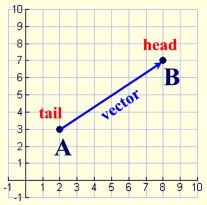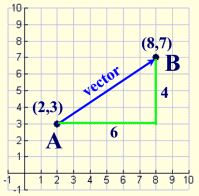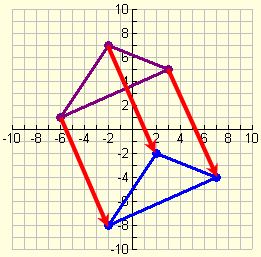Translations and Vectors
Another way to describe a translation is with the use of a vector.
A vector is a quantity that has magnitude (length) and direction.
A vector is represented by a directed line segment, which is a segment with an arrow at one end indicating the direction of movement. Unlike a ray, a directed line segment has a specific length.
 The direction is indicated by an arrow pointing from the tail (the initial point) to the head (the terminal point). If the tail is at point A and the head is at point B, the vector from A to B is written as:
The direction is indicated by an arrow pointing from the tail (the initial point) to the head (the terminal point). If the tail is at point A and the head is at point B, the vector from A to B is written as:
notation:
![]()
(Vectors may also be labeled as a single bold face letter, such as vector v.)
The length (magnitude) of a vector v is written |v|. Length is always a non-negative real number.
As you can see in the diagram at the right, the length of a vector can be found by forming a right triangle and utilizing the Pythagorean Theorem or by using the Distance Formula.
 The vector below translates 6 units to the right and 4 units upward. The magnitude of the vector is 2√3 from the Pythagorean Theorem, or from the Distance Formula:
The vector below translates 6 units to the right and 4 units upward. The magnitude of the vector is 2√3 from the Pythagorean Theorem, or from the Distance Formula:
![]() The direction of a vector is determined by the angle it makes with a horizontal line.
The direction of a vector is determined by the angle it makes with a horizontal line.
In the below diagram, to find the direction of the vector (in degrees) we will utilize trigonometry. The tangent of the angle formed by the vector and the horizontal line (the one drawn parallel to the x-axis) is 4/6 (opposite/adjacent).

 Translations and vectors: The translation at the left shows a vector translating the top triangle 4 units to the right and 9 units downward. The notation for such vector movement may be written as:
Translations and vectors: The translation at the left shows a vector translating the top triangle 4 units to the right and 9 units downward. The notation for such vector movement may be written as:

 Vectors such as those used in translations are what is known as free vectors. Any two vectors of the same length and parallel to each other are considered identical. They need not have the same initial and terminal points.
Vectors such as those used in translations are what is known as free vectors. Any two vectors of the same length and parallel to each other are considered identical. They need not have the same initial and terminal points.
A free vector is an infinite set of parallel directed line segments and can be thought of as a translation. Notice that the vectors in this translation which connect the pre-image vertices to the image vertices are all parallel and are all the same length.
You may also hear the terms “displacement” vector or “translation” vector when working with translations.
Position vector:
To each free vector (or translation), there corresponds a position vector which is the image of the origin under that translation.
 Unlike a free vector, a position vector is “tied” or “fixed” to the origin. A position vector describes the spatial position of a point relative to the origin.
Unlike a free vector, a position vector is “tied” or “fixed” to the origin. A position vector describes the spatial position of a point relative to the origin.
